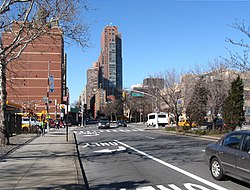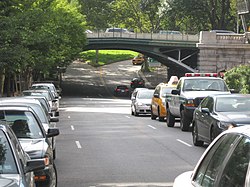96th Street (Manhattan)



The 96th Street is a main street that New York City's borough Manhattan crosses from west to east.
Location and course
96th Street runs through East Harlem and the Upper West Side . It extends from the East River in the east on FDR Drive to the Henry Hudson Parkway on the Hudson River in the west. In east Manhattan, 96th Street is the border between Yorkville in the south and Spanish Harlem in the north.
The street is interrupted by Central Park . There are feeders in the park that connect 96th Street with 97th Street Transverse road (also: Transverse Road # 4), which runs through the park and connects the East Side with the Westside via 96th Street and 97th Street. The pedestrian gate to Central Park at 96th Street is called "Gate of all Saints" on the west side and "Woodmans Gate" on the east side.
On the Upper West Side , 96th Street slowly descends into a natural valley, which is also understood as the southern boundary of the neighboring Manhattan Valley , runs under Riverside Drive and has a feeder to Henry Hudson Parkway .
history
96th Street is one of 15 blocks in New York City that is approximately 30.5 meters (100 feet) wide. This was set out in the Commissioners' Plan of 1811 , which also regulated the entire street grid of Manhattan from 14th Street to Washington Heights .
For several decades, 96th Street, at least east of Park Avenue , was an invisible border between the affluent Upper East Side and the densely populated, but also significantly poorer, Spanish Harlem . Portions of 96th Street, particularly around Second Avenue and Third Avenue , experienced significant gentrification with luxury apartment blocks built by Related Rentals in the late 1980s.
96th Street is the northern limit of the New York City steam system , which heats over 100,000 buildings with more than 13.6 million tons (30 billion pounds) of hot water vapor annually - the largest heating system of its kind in the world.
Local transport
The New York subway has the following stops along 96th Street:
- 96th Street (IRT Broadway - Seventh Avenue Line) on Broadway
- 96th Street (IND Eighth Avenue Line) on Central Park West
- 96th Street (IRT Lexington Avenue Line) on Lexington Avenue
- 96th Street (IND Second Avenue Line) is currently under construction on Second Avenue .
The M96 bus route serves almost all of 96th Street and the M106 bus route serves the western part of the street and connects it to East 106th Street.
Web links
Individual evidence
- ↑ Hinds, Michael DeCourcy: "Battling TO CONTROL E. 96TH GROWTH" , The New York Times , May 13, 1984, accessed on 5 December 2007, "EAST 96TH STREET is not just a dull part of real estate - it's a social important corridor, 'says August Heckscher . 'With El Barrio in the north and Yorkville in the south, it could be a meeting point for two cultures, a river into which both flow. " -"' EAST 96TH STREET is not just a dead piece of real estate - it is a socially important corridor ' , said August Heckscher. 'With El Barrio to the north and Yorkville to the south, it could be the meeting place of two cultures, a river into which both flow.' "
- ↑ Lee, Denny: "NEIGHBORHOOD REPORT: EAST HARLEM; A 'Museo' Moves Away From Its Barrio Identity" , The New York Times , July 21, 2002 called on 5 December 2007, "The quarter north of East 96th Street sometimes called East Harlem or Spanish Harlem, but the local Puerto Ricans call it affectionately El Barrio. " -" the neighborhood north of East 96th Street is sometimes called East Harlem or Spanish Harlem, but local Puerto Ricans affectionately call it El Barrio ".
- ↑ Cohen, Joyce. “If You're Thinking of Living On / Central Park West; At Every Front Door, a Great Playground " , The New York Times , September 3 2000 called on 5 December 2007, " North of 96th Street, where the area known as Manhattan Valley is known to be the Avenues modest with a mix of Housing associations, condominiums and rental houses. " -" North of 96th Street, where the area is known as Manhattan Valley, the avenue turns more modest, with a mix of housing associations, condominiums and rentals. "
- ↑ Nieves, Evelyn: "Manhattan Valley's Long Awaited Boom Ends Up Just a Fizzle" , The New York Times , December 25, 1990, accessed on 5 December 2007 "... Manhattan Valley, a short valley between the Upper West Side and Harlem, from 100th Street to 110th Street and from Central Park West to Broadway ... " -" ... Manhattan Valley, a quick dip between the Upper West Side and Harlem, from 100th Street to 110th Street and Central Park West to Broadway ... "
- ↑ The Commissioner's remarks on the New York City streets and lanes elevation under the April 3, 1807 Act (accessed May 2, 2007): “The streets are all 60 feet wide except 15, which are 100 feet wide. These are numbers 14, 23, 34, 42, 57, 72, 79, 86, 96, 106, 116, 125, 135, 145, and 155 - the block or distance between these is generally about 200 feet. " -" These streets are all sixty feet wide except fifteen, which are one hundred feet wide, viz .: Numbers fourteen, twenty-three, thirty-four, forty-two, fifty-seven, seventy-two, seventy-nine, eighty-six , ninety-six, one hundred and six, one hundred and sixteen, one hundred and twenty-five, one hundred and thirty-five, one hundred and forty-five, and one hundred and fifty-five - the block or space between them being in general about two hundred feet. "
- ^ Dividing Line Between Upper East Side and Harlem Blurring
- ↑ Steam (Gotham Gazette, November 10, 2003)
